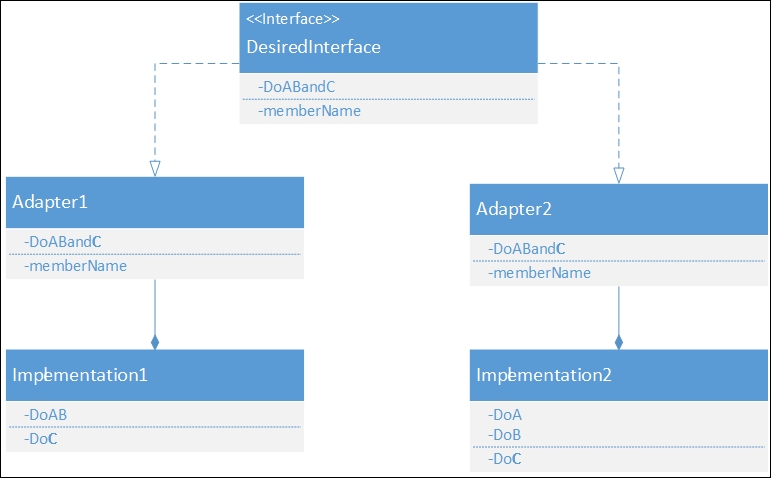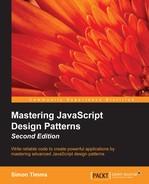The bridge pattern takes the adapter pattern to a new level. Given an interface, we can build multiple adapters, each one of which acts as an intermediary to a different implementation.
An excellent example that I've run across, is dealing with two different services that provide more or less the same functionality and are used in a failover configuration. Neither service provides exactly the interface required by the application and both services provide different APIs. In order to simplify the code, adapters are written to provide a consistent interface. The adapters implement a consistent interface and provide fills so that each API can be called consistently. To expand on the shape sorter metaphor a bit more, we can imagine that we have a variety of different pegs we would like to use to fill the square hole. Each adapter fills in the missing bits and helps us get a good fit:

The bridge is a very useful pattern. Let's take a look at how to implement it:

The adapters shown in the preceding diagram sit between the implementation and the desired interface. They modify the implementation to fit in with the desired interface.
We've already discussed that in the land of Westeros the people practice a number of disparate religions. Each one has a different way of praying and making offerings. There is a lot of complexity around making the correct prayers at the correct time and we would like to avoid exposing this complexity. Instead we'll write a series of adapters that can simplify prayers.
The first thing we need is a number of different gods to which we can pray:
class OldGods {
prayTo(sacrifice) {
console.log("We Old Gods hear your prayer");
}
}
Religion.OldGods = OldGods;
class DrownedGod {
prayTo(humanSacrifice) {
console.log("*BUBBLE* GURGLE");
}
}
Religion.DrownedGod = DrownedGod;
class SevenGods {
prayTo(prayerPurpose) {
console.log("Sorry there are a lot of us, it gets confusing here. Did you pray for something?");
}
}
Religion.SevenGods = SevenGods;These classes should look familiar as they are basically the same classes found in the previous chapter where they were used as examples for the factory method. You may notice, however, that the signature for the prayTo method for each religion is slightly different. This proves to be something of an issue when building a consistent interface like the one shown in pseudo code here:
interface God
{
prayTo():void;
}So let's slot in a few adapters to act as a bridge between the classes we have and the signature we would like the following:
class OldGodsAdapter {
constructor() {
this._oldGods = new OldGods();
}
prayTo() {
let sacrifice = new Sacrifice();
this._oldGods.prayTo(sacrifice);
}
}
Religion.OldGodsAdapter = OldGodsAdapter;
class DrownedGodAdapter {
constructor() {
this._drownedGod = new DrownedGod();
}
prayTo() {
let sacrifice = new HumanSacrifice();
this._drownedGod.prayTo(sacrifice);
}
}
Religion.DrownedGodAdapter = DrownedGodAdapter;
class SevenGodsAdapter {
constructor() {
this.prayerPurposeProvider = new PrayerPurposeProvider();
this._sevenGods = new SevenGods();
}
prayTo() {
this._sevenGods.prayTo(this.prayerPurposeProvider.GetPurpose());
}
}
Religion.SevenGodsAdapter = SevenGodsAdapter;
class PrayerPurposeProvider {
GetPurpose() { }
}
Religion.PrayerPurposeProvider = PrayerPurposeProvider;Each one of these adapters implements the God interface we wanted and abstracts away the complexity of dealing with three different interfaces, one for each god:
To use the Bridge pattern, we could write code like so:
let god1 = new Religion.SevenGodsAdapter();
let god2 = new Religion.DrownedGodAdapter();
let god3 = new Religion.OldGodsAdapter();
let gods = [god1, god2, god3];
for(let i =0; i<gods.length; i++){
gods[i].praryTo();
}This code uses the bridges to provide a consistent interface to the gods such that they can all be treated as equals.
In this case we are simply wrapping the individual gods and proxying method calls through to them. The adapters could each wrap a number of objects and this is another useful place in which to use the adapter. If a complex series of objects needs to be orchestrated, then an adapter can take some responsibility for that orchestration providing a simpler interface to other classes.
You can imagine how useful the bridge pattern is. It can be used well in conjunction with the factory method pattern presented in the previous chapter.
This pattern certainly remains a very useful one for use in JavaScript. As I mentioned at the start of this section, it is handy for dealing with different APIs in a consistent fashion. I have used it for swapping in different third party components such as different graphing libraries or phone system integration points. If you're building applications on a mobile platform using JavaScript, then the bridge pattern is going to be a great friend for you, allowing you to separate your common and platform specific code cleanly. Because there are no interfaces in JavaScript, the bridge pattern is far closer to the adapter in JavaScript than in other languages. In fact, it is basically exactly the same.
A bridge also makes testing easier. We are able to implement a fake bridge and use this to ensure that the calls into the bridge are correct.
